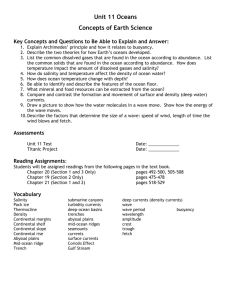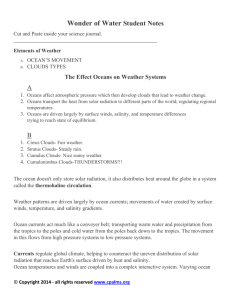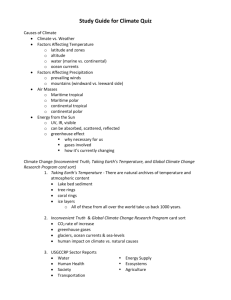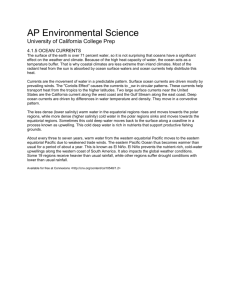Ocean Study Guide 2016 Key
advertisement
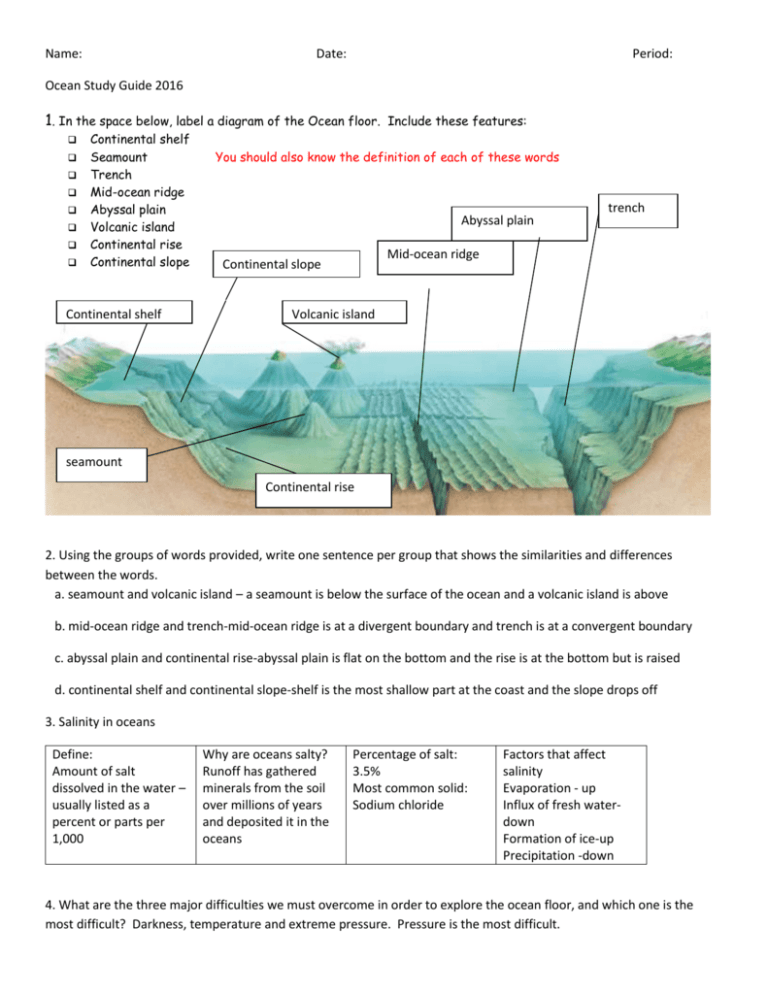
Name: Date: Period: Ocean Study Guide 2016 1. In the space below, label a diagram of the Ocean floor. Include these features: Continental shelf Seamount Trench Mid-ocean ridge Abyssal plain Volcanic island Continental rise Continental slope Continental shelf You should also know the definition of each of these words Abyssal plain trench Mid-ocean ridge Continental slope Volcanic island seamount Continental rise 2. Using the groups of words provided, write one sentence per group that shows the similarities and differences between the words. a. seamount and volcanic island – a seamount is below the surface of the ocean and a volcanic island is above b. mid-ocean ridge and trench-mid-ocean ridge is at a divergent boundary and trench is at a convergent boundary c. abyssal plain and continental rise-abyssal plain is flat on the bottom and the rise is at the bottom but is raised d. continental shelf and continental slope-shelf is the most shallow part at the coast and the slope drops off 3. Salinity in oceans Define: Amount of salt dissolved in the water – usually listed as a percent or parts per 1,000 Why are oceans salty? Runoff has gathered minerals from the soil over millions of years and deposited it in the oceans Percentage of salt: 3.5% Most common solid: Sodium chloride Factors that affect salinity Evaporation - up Influx of fresh waterdown Formation of ice-up Precipitation -down 4. What are the three major difficulties we must overcome in order to explore the ocean floor, and which one is the most difficult? Darkness, temperature and extreme pressure. Pressure is the most difficult. 5. Ocean column: describe the light, temperature, and pressure in each zone. In general terms, as you go deeper the temperature and sunlight decrease and the pressure increases Surface zone Has sunlight, temperature is fairly constantabout 24 degrees C, little pressure Thermocline Little sunlight, temperature makes a drastic drop from 24 degrees to about 4 degrees C, pressure increases as you go deeper Deep zone No sunlight, very cold, extreme amounts of pressure ` 6. Oceans cover what percentage of the earth’s surface? About 70 7. Oceans contain ___97%___ % of the Earth’s water. 8. List the names of the oceans from largest to smallest. Pacific, Atlantic, Indian, Southern, Arctic 9. How many planets in our solar system have liquid water at the surface? Only earth 10. Why does the ocean usually appear to be blue? Though all of the colors of the rainbow are in sunlight, some wavelengths are absorbed and some are reflected off the surface and reflect the color of the sky. 11. How are the ocean currents affected by: (include surface and deep currents) Temperature – warm surface currents form near the equator and carry warm water toward the poles, cold surface currents form near the poles and carry cold water to the equator – this helps distribute the sun’s energy throughout the globe Winds – Global wind patterns cause surface currents by blowing across the surface of the water and moving it – helps moderate the world’s climates Salinity – the more salinity the more dense the water which causes it to sink and create deep ocean currents Density – differences in density cause the deep water currents. When more dense water sinks, surface water moves in causing a surface current. Deep currents are colder, and saltier and therefore more dense than surface currents Coriolis effect – caused by the rotation of the Earth – it causes currents to travel in curved paths – clockwise in the Northern Hemisphere and counterclockwise in the Southern Hemisphere 12. Use the word upwelling to describe how deep and surface currents are related. When a local surface current moves water away from the coast of South America the water from a deep current comes up to replace it. This upwelling brings up nutrients and minerals for fish. 13. Describe the effect of cold and warm currents on climate: cold water currents bring cold water and cause the climate to be colder (California, for example) while warm water currents bring warm water and cause climates to be warmer than areas not on the coast. England is an example of being warmed by the Gulf Stream and therefore having a milder winter than areas further inland. 14. What factors affect the formation of a wave? How far, how fast and how long the wind, that is causing the wave, blows. Remember waves travel through water; they don’t take the water with them. The energy travels, not the water. 15. Two students designed an experiment to determine whether the depth of water in the container affected how quickly the water evaporated. Independent variable (one that you changed): how much water you put in the container – how deep Dependent variable (one that you measure): how much water evaporated in a certain amount of time Controls (things that stay the same) same container, same amount of time in the sun, same temperature of the water Also know: The difference between water movement in a current and a wave. Currents move water great distances like rivers inside the ocean. Waves move energy but not water. What are tsunamis? Why is water conservation important? Review your quiz from 13.1 and 13.2 – you will see many of the same questions Review question are from fresh water – remember rivers, watersheds, aquifers etc.?
